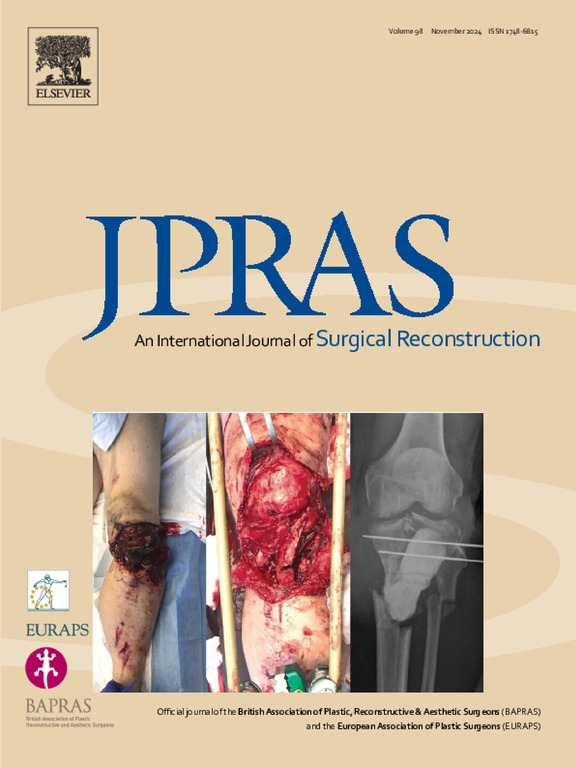使用 BREAST-Q 对深动脉穿孔器 (PAP) 乳房重建与深下上腹部穿孔器 (DIEP) 乳房重建的患者报告和手术效果进行比较
IF 2
3区 医学
Q2 SURGERY
Journal of Plastic Reconstructive and Aesthetic Surgery
Pub Date : 2025-03-01
DOI:10.1016/j.bjps.2024.01.031
引用次数: 0
摘要
背景自体乳房重建患者需要进行全面评估,股深动脉穿孔器瓣(PAP)已成为与下腹穿孔器瓣(DIEP)并列的重要自体乳房重建选择。乳房重建对患者的心理、身体和精神都有影响。BREAST-Q 可以帮助评估患者报告的疗效指标 (PROM)。我们旨在通过临床随访和 PROMs,对 DIEP 和 PAP 患者的术后临床效果、美学效果、发病率和患者满意度进行批判性比较。研究纳入了 2021 年 1 月至 2022 年 2 月间接受 PAP 或 DIEP 重建手术的患者,并进行了至少一年的术后随访。研究人员采集了患者的人口统计学和围手术期数据。结果 157 名患者进行了自体乳房重建(207 个皮瓣),其中 129 名(82.1%)为 DIEP 患者,21 名(13.3%)为 PAP 患者。37例(28.6%)患者进行了双侧DIEP重建,1例(5%)PAP患者进行了双侧重建。其余的 PAP 病例为单侧乳房重建的叠层皮瓣。PAP 平均缺血时间为 55.29 (+/- 15.59 分钟),而 DIEP 平均缺血时间为 69.52 (+/- 21.74 分钟)(P=0.014)。结论在一年的随访中,DIEP和PAP皮瓣重建术在所有领域的PROMs方面均无明显差异。这反映出,尽管PAP皮瓣的供体部位更具挑战性,且供体部位并发症较高,但与黄金标准的DIEP皮瓣重建相比,PAP皮瓣是一种极佳的重建选择,且患者报告的结果相似。本文章由计算机程序翻译,如有差异,请以英文原文为准。
Patient-reported and surgical outcomes of profunda artery perforator (PAP) flap breast reconstructions compared to deep inferior epigastric perforator (DIEP) using BREAST-Q
Background
Autologous breast reconstruction patients require thorough assessment, with the profunda femoris artery perforator (PAP) flap having become an important autologous reconstruction option alongside the deep inferior epigastric perforator (DIEP) flap. Breast reconstruction impacts patients psychologically, physically and mentally. The BREAST-Q aids in the assessment of patient-reported outcome measures (PROMs). We aim to critically compare postoperative clinical outcomes, aesthetic results, morbidity and patient satisfaction between patients undergoing DIEP and PAP flap reconstructions using clinical follow-up and PROMs.
Methods
A non-blinded two-armed prospective cohort study was performed. Patients undergoing PAP or DIEP flap reconstructions between January 2021 and February 2022 were included and followed up for at least one-year postoperatively. Demographic and per-operative data were acquired. BREAST-Q data were collected preoperatively and at 2-week, 3-month and 1-year intervals postoperatively.
Results
157 patients had autologous breast reconstruction (207 flaps), with 129 (82.1%) DIEP patients and 21 (13.3%) PAP patients. 37 (28.6%) patients underwent bilateral DIEP reconstructions, and 1 (5%) PAP case was bilateral. The remaining PAP cases used stacked flaps for unilateral breast reconstruction. Mean ischaemia time for PAP was 55.29 (±15.59 minutes) compared to 69.52 (±21.74 minutes) for DIEP (p = 0.014). Donor site wound dehiscence was significantly higher with PAP reconstructions (p = 0.014).
Conclusions
At one-year follow-up, no significant differences in PROMs across all domains between DIEP and PAP flap reconstructions were noted. This reflects that PAP flap reconstructions, despite having a more challenging donor site and higher donor site complications, provide an excellent reconstructive option with similar patient-reported outcomes when compared to the gold-standard DIEP flap reconstruction.
求助全文
通过发布文献求助,成功后即可免费获取论文全文。
去求助
来源期刊
CiteScore
3.10
自引率
11.10%
发文量
578
审稿时长
3.5 months
期刊介绍:
JPRAS An International Journal of Surgical Reconstruction is one of the world''s leading international journals, covering all the reconstructive and aesthetic aspects of plastic surgery.
The journal presents the latest surgical procedures with audit and outcome studies of new and established techniques in plastic surgery including: cleft lip and palate and other heads and neck surgery, hand surgery, lower limb trauma, burns, skin cancer, breast surgery and aesthetic surgery.

 求助内容:
求助内容: 应助结果提醒方式:
应助结果提醒方式:


